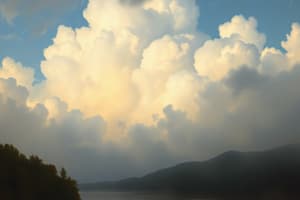Podcast
Questions and Answers
How does evaporation affect the surrounding environment?
How does evaporation affect the surrounding environment?
- It causes an increase in atmospheric pressure.
- It warms the environment by releasing heat.
- It has no impact on the temperature of the environment.
- It cools the environment by absorbing heat. (correct)
Which of the following conditions would increase the rate of evaporation?
Which of the following conditions would increase the rate of evaporation?
- Calm winds and low water temperature
- Lower air temperature and high saturation of the air
- Higher air temperature and low saturation of the air (correct)
- High saturation of the air and calm winds
How does absolute humidity change as air rises and descends in the atmosphere?
How does absolute humidity change as air rises and descends in the atmosphere?
- It fluctuates randomly with changes in altitude.
- It remains constant regardless of air movement.
- It decreases as air rises and increases as air descends. (correct)
- It increases as air rises and decreases as air descends.
If the water vapor content in the air remains constant, what happens to the relative humidity as the temperature increases?
If the water vapor content in the air remains constant, what happens to the relative humidity as the temperature increases?
Why does cooking take longer at higher altitudes?
Why does cooking take longer at higher altitudes?
Which of the following is NOT a necessary condition for condensation to occur?
Which of the following is NOT a necessary condition for condensation to occur?
Which type of fog is formed when warm, moist air moves over a cold surface?
Which type of fog is formed when warm, moist air moves over a cold surface?
What process is primarily responsible for the incremental growth of water droplets in clouds?
What process is primarily responsible for the incremental growth of water droplets in clouds?
Which lifting mechanism is most associated with air rising due to elevation changes?
Which lifting mechanism is most associated with air rising due to elevation changes?
What atmospheric condition results in a strong cyclone?
What atmospheric condition results in a strong cyclone?
What does the 'm' in an air mass code (e.g., mT) indicate?
What does the 'm' in an air mass code (e.g., mT) indicate?
Which type of front is associated with a warmer air mass invading a region occupied by a colder air mass?
Which type of front is associated with a warmer air mass invading a region occupied by a colder air mass?
What is a primary characteristic of a cold front?
What is a primary characteristic of a cold front?
What is the typical lifespan of an extratropical cyclone?
What is the typical lifespan of an extratropical cyclone?
What is the minimum wind speed required for a storm to be classified as a hurricane?
What is the minimum wind speed required for a storm to be classified as a hurricane?
Why do hurricanes weaken when they move over land?
Why do hurricanes weaken when they move over land?
Which of the following ocean areas typically does NOT experience hurricanes or typhoons?
Which of the following ocean areas typically does NOT experience hurricanes or typhoons?
During what months is hurricane season most active in the Northern Hemisphere?
During what months is hurricane season most active in the Northern Hemisphere?
Which part of a hurricane has the highest wind speeds and is the most destructive?
Which part of a hurricane has the highest wind speeds and is the most destructive?
Which scale is used to measure the intensity of a hurricane?
Which scale is used to measure the intensity of a hurricane?
Where is Tornado Alley primarily located in the United States?
Where is Tornado Alley primarily located in the United States?
During which months is tornado activity typically at its peak in the central United States (Tornado Alley)?
During which months is tornado activity typically at its peak in the central United States (Tornado Alley)?
What characterizes the mature stage of thunderstorm development?
What characterizes the mature stage of thunderstorm development?
What is a microburst?
What is a microburst?
Where does the positive charge accumulate in a thunderstorm cloud, according to the information?
Where does the positive charge accumulate in a thunderstorm cloud, according to the information?
What role does Earth's rotation play in hurricane formation?
What role does Earth's rotation play in hurricane formation?
Which of the following best describes the 'eye' of a hurricane?
Which of the following best describes the 'eye' of a hurricane?
Why is weak vertical wind shear a necessary ingredient for hurricane formation?
Why is weak vertical wind shear a necessary ingredient for hurricane formation?
In the context of air masses, what does 'cT' indicate?
In the context of air masses, what does 'cT' indicate?
Flashcards
Evaporation
Evaporation
The conversion of a liquid to a gas, requiring energy and resulting in a cooling effect.
Condensation
Condensation
The conversion of a gas to a liquid, releasing energy and resulting in a warming effect.
Absolute Humidity
Absolute Humidity
The weight of water vapor in a given volume of air; changes with air expansion and compression.
Specific Humidity
Specific Humidity
Signup and view all the flashcards
Relative Humidity
Relative Humidity
Signup and view all the flashcards
Adiabatic Processes
Adiabatic Processes
Signup and view all the flashcards
Windward Air
Windward Air
Signup and view all the flashcards
Leeward Air
Leeward Air
Signup and view all the flashcards
Conditions for Condensation
Conditions for Condensation
Signup and view all the flashcards
Radiation Fog
Radiation Fog
Signup and view all the flashcards
Advection Fog
Advection Fog
Signup and view all the flashcards
Upslope Fog
Upslope Fog
Signup and view all the flashcards
Evaporation Fog
Evaporation Fog
Signup and view all the flashcards
Convective Lifting
Convective Lifting
Signup and view all the flashcards
Orographic Lifting
Orographic Lifting
Signup and view all the flashcards
Convergence of Air
Convergence of Air
Signup and view all the flashcards
Frontal Lifting
Frontal Lifting
Signup and view all the flashcards
Air Mass
Air Mass
Signup and view all the flashcards
Air Mass Source Regions
Air Mass Source Regions
Signup and view all the flashcards
Air Mass Temperature Classifications
Air Mass Temperature Classifications
Signup and view all the flashcards
Front
Front
Signup and view all the flashcards
Warm Front
Warm Front
Signup and view all the flashcards
Cold Front
Cold Front
Signup and view all the flashcards
Stationary Front
Stationary Front
Signup and view all the flashcards
Air Mass Modification
Air Mass Modification
Signup and view all the flashcards
Extratropical Cyclones
Extratropical Cyclones
Signup and view all the flashcards
Hurricane
Hurricane
Signup and view all the flashcards
Hurricane Formation Ingredients
Hurricane Formation Ingredients
Signup and view all the flashcards
Hurricane Eye
Hurricane Eye
Signup and view all the flashcards
Hurricane Eye Wall
Hurricane Eye Wall
Signup and view all the flashcards
Study Notes
- Evaporation cools the environment, while condensation warms it.
- Evaporation rate is affected by air/water temperature, air saturation, and windiness.
Measures of Humidity
- Absolute humidity is the weight of water in a given volume of air, changing with altitude.
- It's calculated as the mass of water vapor divided by the volume of air.
- Specific humidity is the weight of water in a given weight of air.
- It's calculated as the mass of water vapor divided by the total mass of air.
- Relative humidity is the percentage of water in air compared to saturation.
- Water Vapor Content/Water Vapor Capacity = Actual Vapor Pressure/ Saturation Vapor Pressure x 100%
- Temperature and water amount differences influence relative humidity.
- Condensation can occur at high temperatures when vapor pressure reaches saturation.
Adiabatic Processes
- Rising or falling air experiences temperature changes.
- As altitude increases:
- Temperature, pressure, and density decrease.
- Relative humidity and air volume increase.
- Air expansion leads to temperature drops.
- Windward sides involve air rising under dry and wet adiabatic conditions.
- Leeward sides involve air descending under dry adiabatic conditions.
Vapor Pressure and Boiling
- Higher altitudes increase cooking times.
- The boiling point of water changes with atmospheric pressure.
Conditions for Condensation
- Air must be saturated (RH=100%).
- A surface must be available for condensation.
Formation of Fog
- Radiation Fog:
- Forms near the ground on clear, calm nights.
- Ground heat loss cools the air above it to the dew point, causing condensation.
- Advection Fog:
- Warm, moist air moves horizontally over a cold surface.
- Cooling causes the air to reach its dew point, forming fog.
- Upslope Fog:
- Moist, stable air is pushed uphill by wind.
- Air expands and cools to its dew point, forming fog along the slope.
- Evaporation Fog:
- Cold air passes over a warmer, moist surface.
- Water evaporates, mixes with cooler air, and reaches the dew point.
Cloud Types
- Cirriform, Stratiform, and Cumuliform are common cloud patterns.
- Thunderstorms come from Mesocyclone clouds.
- Clouds are categorized by altitude: high, middle, low, and vertical development.
Forms of Precipitation
- Includes rain, snow, sleet, and hail.
- Collision and coalescence of water droplets is responsible for droplet growth.
- Droplet form shape is not tear drop, but circular.
- Precipitation type depends on the time the snow or droplet is falling.
Causes of Lifting Air and Precipitation
- Convective Lifting: Warm, moist air rises.
- Orographic Lifting: Air rises due to elevation on the windward side.
- Convergence of Air: Low pressure causes air to rise.
- Frontal Lifting: Air rises along frontal boundaries.
Converging and Diverging Air
- Strong Cyclone: Upper-level divergence exceeds surface convergence, lowering surface pressure.
- Weak Cyclone: Upper-level divergence is less than surface convergence, increasing surface pressure.
- Strong Anticyclone: Upper-level convergence exceeds low-level divergence, increasing surface pressure.
- Weak Anticyclone: Upper-level convergence is less than low-level divergence, decreasing surface pressure.
Air Mass Source and Classification
- Air Mass: Large air body with similar temperature and moisture.
- Two-letter codes:
- First letter: 'm' (maritime, moist) or 'c' (continental, dry).
- Second letter: E (Equatorial, very warm), T (Tropical, warm), P (Polar, cold), A (Arctic, very cold).
- Examples: cT (Continental Tropical), mE (Maritime Equatorial).
Fronts
- Fronts separate air masses and do not readily mix.
- Fronts are sloping boundaries where warmer, lighter air rises over cooler, denser air, causing frontal uplift.
Types of Fronts
- Warm Front:
- Warm air mass invades a colder region.
- Gentle slope, less violent weather.
- Cold Front:
- Cold air mass moves into a warmer air mass.
- Steeper slope, sharp changes in temperature, pressure, and wind.
- Can cause heavy precipitation and violent thunderstorms.
- Stationary Front:
- Frontal boundary with little movement due to small temperature and pressure gradients.
- Light wind and precipitation, overcast conditions.
- Occluded Front:
- Cyclonic systems.
Movement and Modification of Air Masses
- Changes when air mass moves away from source region:
- Thermal modification
- Dynamic modification
- Moisture addition or subtraction.
Major Atmospheric Disturbances: Extratropical Cyclones
- Mid-latitudes cyclone are the battle ground for air masses.
- Move within the Westerlies.
- Cold front moves faster.
- Life cycle of 4 to 7 days.
Major Atmospheric Disturbances: Hurricanes
- Tropical Depression: Winds less than 36 mph.
- Tropical Storm: Winds between 36-74 mph.
- Hurricane: Winds greater than 74 mph.
- Low-pressure center with strong cyclonic winds spiraling inwards.
- Smaller than extratropical cyclones (100-600 miles diameter).
- Eye diameter is 10-25 miles.
- Energy from latent heat evaporated from tropical oceans.
- Require warm ocean water (>27°C to 50m deep), weak vertical wind shear, and position >8° N/S.
- Hurricanes never form over the Equator due to the lack of the Coriolis effect.
- Hurricanes weaken over land due to lack of warm water.
Coriolis Effect
- Earth's rotation that influences hurricanes.
- Hurricane-free ocean areas: E. South Pacific Ocean, South Atlantic, and Equator due to cold water. Hurricane season peaks in August, September, and October.
- Hurricanes are measured on a 1-5 category scale.
- Hurricane Names:
- Australia: Willy-Willy
- Caribbean: Hurricane
- Haiti: Taino
- Indian Ocean: Cyclone
- Philippines: Baguio
- S. Pacific: Typhoon
- Hurricane names are reused every seven years and alternate
- Hurricane structure is a eye with clear sky, and the eye wall has the highest wind speed.
Hurricane Development
- Develop over warm ocean areas, not over the Equator, South Pacific Ocean, and South Atlantic Ocean.
- Mid-latitude cyclones develop over land.
- Necessary Ingredients:
- Ocean water > 27°C to 50 meters deep.
- Weak vertical wind shear.
- Position >8 degrees N/S.
Anatomy Terms
- Eye: Patch of clear sky.
- Eye Wall: Violent, destructive, intense low-pressure system.
Intensity Scales
- Tornado: Enhanced Fujita Scale
- Hurricane: Saffir-Simpson scale/ Category
Minor Disturbances: Tornados and Thunderstorms
- Tornado Ally is centered in: Texas, through Oklahoma, Kansas, Nebraska, South Dakota, Iowa.
- Seasonal Tornado Activity:
- Deep South: JAN/FEB/MAR
- Ally: APR/MAY/JUN
- Mid: JUL/AUG/SEPT
Thunderstorm Development
- Cumulus stage: Heated air rises.
- Mature stage: Up and down drafts.
- Dissipating stage: Descending air.
- Microburst: Sudden, powerful, localized air current.
Lightening
- Earth's surface has a positive charge.
- Ice crystals in the top of a thunderstorm cloud have a positive (+) charge, while hailstone below have a negative (-) charge.
- Electrical flow rushes toward earth when the negative charge is large enough to overcome air resistance.
Studying That Suits You
Use AI to generate personalized quizzes and flashcards to suit your learning preferences.




